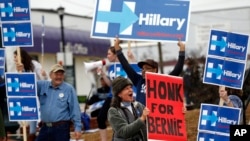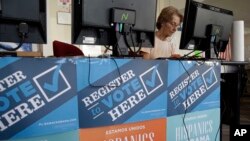Over samosas and biryani, a monthly meeting of the Indian Association of New Hampshire quickly turns to talk of the U.S. election.
"Whoever it is, a presidential candidate must be all-inclusive and take into consideration our demographic," says IANH President Balaji Radakrishnan.
In the kitchen of Radakrishnan's New Hampshire home, the debate centers on who would make a better president: former Secretary of State Hillary Clinton or the Democratic senator from neighboring Vermont, Bernie Sanders.
"This year, it is more exciting, the possibility of a woman president," notes Jasmine Pandit.
It's no surprise that these assembled Indian-Americans identify as Democrats. And regardless of which candidate they backed in the New Hampshire primary, the group remains unified in its support of the Democratic Party.
"These very strong opinions from the Republicans on issues like immigration, certainly gives one more point towards the Democrats," Pandit says. "I tend to vote Democratic – it's a more open-minded thinking and geared toward equality."
A unified, energized front?
This focus on what the party stands for is critical as the party's presumptive nominee, Hillary Clinton, works to put a contentious primary season behind her and focus on victory in the November 8 election.
"The Democrats at this point are certainly ... more unified than the Republicans. But being unified is one thing, being energized, being excited about the election is something else," says Georgetown University historian Michael Kazin.
The author of American Dreams: How the Left Changed a Nation credits Senator Sanders' presidential campaign with energizing, mobilizing and giving a voice to the left wing of the Democratic party, which had been yearning for a candidate who championed their views.
"As one writer friend Harold Meyerson put it, Bernie Sanders really expressed something that was already there," Kazin says. "He captured a mood which has been building probably since the response by a lot of people against the Iraq War, against George W. Bush's policies."
After more than a year of clashes over policy, Sanders took to a New Hampshire stage on July 12 to publicly back Clinton. He pledged to do everything he can to ensure she wins the U.S. presidency over Republican nominee Donald Trump.
"I think the party has been divided, but Bernie Sanders' endorsement should go a long way to unifying the party," says American University political historian Allan Lichtman.
And adopting some of the Vermont senator's progressive stances, whether it be on trade deals, the minimum wage, or college affordability, should also help Clinton win over Sanders supporters, say political analysts.
"Hillary Clinton has to give people a reason to vote for her, not just vote against Donald Trump," Kazin says. "If she manages to use some of Bernie Sanders' ideas, some of his policies, and put it forth in a very clear, inspiring way – that would give people reason to vote for her."
Getting out the Democratic vote
Tapping into progressive enthusiasm is one aspect, sustaining that mood and ensuring Democratic voters who once supported Sanders get behind Clinton at the ballot box is another, says Hudson Institute Senior Fellow Jeffrey Anderson.
"Clinton is going to have to find a way to bring Sanders' voters into the fold and not just a slim majority of them. She is going to need most of them," Anderson says.
But one look at Sanders' campaign rallies during the primary – a sea of young faces galvanized by promises of free college – highlights another challenge Clinton faces come November.
"A lot of the people who supported Sanders of course were young people who don't vote as often as older people," American University's Kazin says. "More Americans in general are Democrats, but Republicans tend to vote in higher levels than Democrats."
And it's not just young people. The Democratic Party's other core constituencies, such as African-Americans and Latinos, do not historically vote in as large number as Republicans.
It's a problem that Sanders himself has highlighted on the campaign trail, spurring Columbia, South Carolina resident Otto Smith to head to the polls during the South Carolina Democratic primary.
"He said 63 percent of the people don't vote and that affected me," Smith says. "The only way we are going to see real change is to get the people out to vote."
When it comes to getting people to cast their ballot, Georgetown University professor Stephen Wayne notes partisanship is the "single most important variable" that influences turnout and voting behavior.
The author of The Road to the White House says Clinton must channel her party's iconic leaders to unify Democrats and get them to the polls.
"She has got to use all the Democratic symbols from Roosevelt to Lyndon Johnson to Jack Kennedy to Barack Obama to get out the vote, while she demonizes Trump as not only being conservative but being unpredictable and overly emotional."













